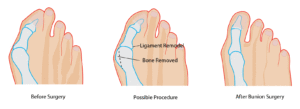Foot Surgery Procedures in New Orleans
We care about you. Our surgical procedures are tailored to provide the best results with the lowest risk and recovery times. Every patient is different, we listen, and provide individualized care at East Jefferson General Hospital, Touro Infirmary and Advanced Surgery Center of Metairie.
Bunion Surgery
95% of our patients walk with full weight-bearing the same day as the surgery with no overnight hospital stay.
6 Myths of Bunion Surgery
A bunion is a structural problem of the big toe joint causing a boney prominence. Surgery is commonly performed to correct the problem. Some people simply avoid surgery because they may have “heard” some misnomers that guide their decision.
Surgery for bunions involves more than just simply shaving the boney protrusion. It typically requires that the deviated bones to be structurally realigned. Milder bunions are corrected with bone cuts close to the big toe joint. Larger bunions typically need a more “involved” bone cut or a fusion procedure to completely realign the structural problem. It takes approximately six weeks for the bones to mend in the corrected position.
Myth #1: Bunion Surgery Is Excruciatingly Painful
Bunion surgery is not particularly “more” painful than other surgeries. Foot surgery, in general, can lend itself to increased pain post-operatively because the foot is below the level of the heart and blood can rush to the area, causing a throbbing feeling. Also, the foot does not have much soft tissue surrounding the bones, so moderate postoperative swelling can aggravate the nerves, causing pain. Most patients find that the postoperative discomfort is tolerable with pain medication and a program dedicated to pain relief.
Myth #2: Bunions Come Back Even After Surgery
A majority of patients are satisfied with their outcome after bunion surgery. Recurrence is possible, but not particularly likely. And, return of a bunion is not necessarily a complication, but something that can happen over time. Some patients have excessive motion in the foot that may predispose them to recurrence. Another possible reason for recurrence occurs when a procedure that was performed did not best suit the severity of the particular bunion — so it’s important to have the surgery tailored for your particular bunion.
Myth #3: Bunion Surgery = Cast and Crutches
While this was true years ago, more modern techniques have allowed surgeons to mobilize patients quicker. Mild bunions typically involve walking in a surgical shoe for six weeks. Surgeons consider casting with crutches with larger bunions because setting the bones is more complex. Some surgeons have moved away from bone cuts and instead perform a fusion procedure that allows for realignment of the entire deviated bone. This fusion procedure is called the Lapidus Bunionectomy, and contemporary approaches allow for early protected walking at two weeks postoperatively. Recent technological advances in medical implant devices have also helped surgeons modify their techniques to get patients moving quicker.
Myth #4: You Have To Be Off Work
This is simply not true, and a function of the demands of your workplace. A patient can return to a sedentary desk job within two weeks of the surgery, and varies based on surgeon protocol and type of bunionectomy performed. Jobs that require excessive walking, standing and physical activity may require a medical leave of absence — which can be up to two months depending on healing and job requirements. Getting around can be difficult and driving may be off limits if you have your right foot operated on and/or drive a manual.
Myth #5: Don’t Fix A Bunion Unless Painful
The concern with surgically correcting a non-painful bunion is that the surgery can result in longstanding post-operative pain that may not have been there prior. However, people do have surgery for non-painful bunions if the bunion interferes with activity, continues to become larger, or if they have difficulty wearing certain shoes and/or if the bunion is simply unsightly. Surgeons strongly prefer (or require) that patients have a painful bunion before they consider surgery. Fortunately, pain is the most common reason people seek treatment.
Myth #6: Healing After Bunion Surgery Results In Unsightly Scars
Surgical healing is part of the process with any surgery, and bunion surgery is no different. Incisions can be minimized, or alternate surgical approaches may be used to hide surgical scars. Bunion incisions are either located on the top of the foot or on the side of the foot, and technique varies based on surgeon. A surgeon may perform a plastic surgery-type closure to keep scaring minimum. Patients can support the healing process with specific targeted dietary supplements to provide the building blocks for proper healing.
Bunion surgery, just like any surgery, has its share of myths. Because not all bunions are treated the same, information that may apply to someone with a large bunion may not apply to someone with a small bunion. Take the time to sort out what is truth vs. myth for your particular problem. Obtaining medical information from family, friends, coworkers and even the Internet will only help you make make an informed decision should you seek surgical advice. Source: Neal Blitz, DPM
Hammertoe Surgery
Greatly reduced healing times with use of new internal hammertoe implants. No external pins or wires, Size specific screws or the new Smart Toe implants are used to help provide improved cosmetic appearance long term functional results.
OPENING HOURS
| Monday | 9:00 – 4:00 |
| Tuesday | 9:00 – 4:00 |
| Wednesday | 9:00 – 4:00 |
| Thursday | 9:00 – 4:00 |
| Friday | 8:00 – 3:00 |
OFFICE LOCATIONS
Metairie
Doctor’s Row
3939 Houma Blvd.
Building 6 Suite 224 Metairie, LA 70006
(504) 454-2900
(504) 454-2915
New Orleans
Touro Medical Office Building
3525 Prytania Street
Suite 230
New Orleans, LA 70115

